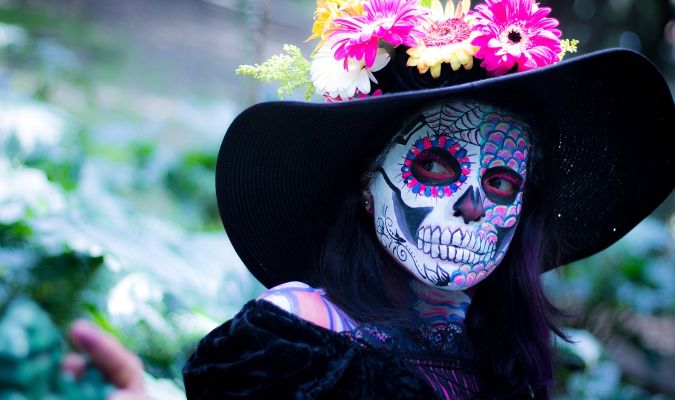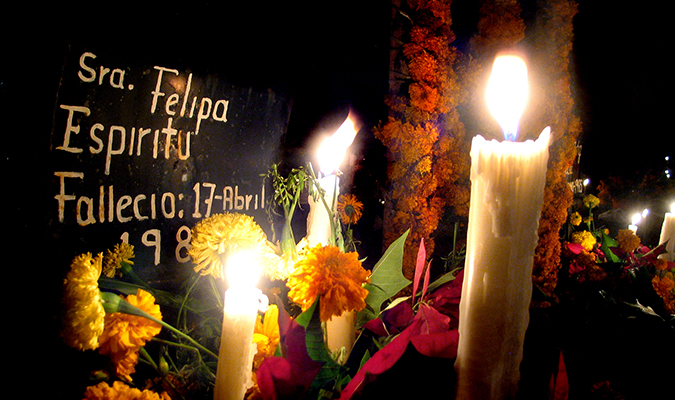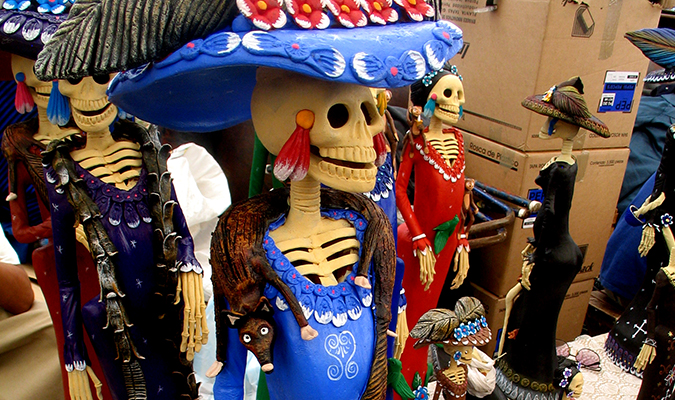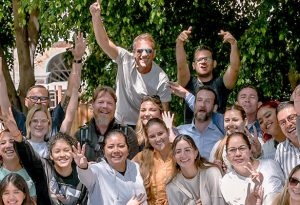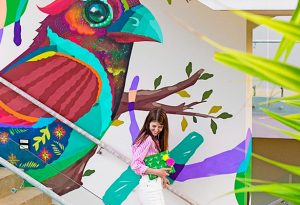If you want to celebrate Day of the Dead in Mexico, there are some fundamentals you’ll need to know. The first – and possibly most important – is that Dia de Muertos is certainly not Halloween! Where Halloween originated from an ancient Celtic festival to scare off spirits, Dia de Muertos is a commemorative celebration of lost loved ones.
Having said that, it’s fair to say that due to their proximity in the calendar and the fact both offer the chance to dress up in elaborate costumes, the separate holidays have conflated in recent years.
In this article, you will learn everything you need to know about Day of the Dead in Mexico.
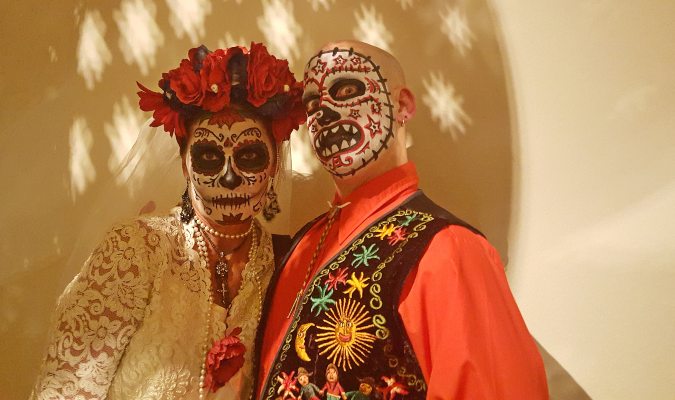
Day of the Dead History
The beginnings of Day of the Dead can be found in a month-long Aztec celebration which honored the gods of the underworld, Mictlantecuhtli and Mictlancíhuatl. Despite taking place in August, this ancient celebration has similarities to the modern Day of the Dead, particularly in the giving of offerings or ofrendas to the deceased.
In the 16th century, the Spanish conquistadores attempted to introduce Catholicism to the native people and essentially eradicate the religions of the indigenous people. They were semi-successful. While the festival moved to the beginnings of November to coincide with the Catholic All Saints Day and All Souls Day, many of the pre-Hispanic traditions continued.
When is Day of the Dead?
Day of the Dead is officially on November 2. However, in some parts of Mexico, the Dia de Muertos celebrations have evolved to include October 31 (Halloween) and November 1 (Dia de los Angelitos).
Day of the Dead 2023 will run from Tuesday, October 31 to Thursday, November 2 – if you include Halloween – or Tuesday, November 1 to Wednesday, November 2 if you don’t.
Did you know: Day of the Dead has been recognized by UNESCO in its List of Intangible Cultural Heritage of Humanity.
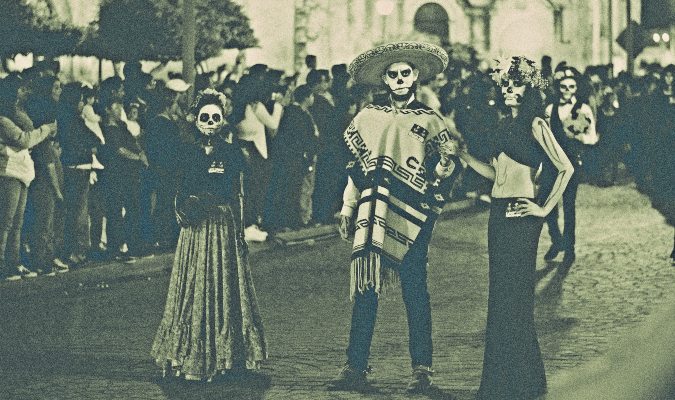
Day of the Dead Traditions
Day of the Dead traditions run from solemn rituals that pay tribute to deceased relatives to brightly colored celebrations of incredible costumes and face painting.
While there are “Dia de Muertos traditions”, it’s also important to note that the Dia de Muertos festivities vary widely throughout the different regions of Mexico. Here are some things to look out for:
Building Altars
For many, building altars (also known as ofrendas) to deceased loved ones is the focal point of the Day of the Dead celebrations. These ritual alters can be built in family homes, cemeteries, and even in public spaces (particularly for former civic leaders). Tradition has it that these altars will help the spirits find their way back to the land of the living for Day of the Dead.
Ofrendas
As well as building altars, friends and families will decorate them with offerings or ofrendas for their loved ones. Typical ofrendas include candles, pan de muerto (more on that later), photographs of the deceased, and their favorite food and drink. It’s not uncommon to see the dead’s favorite packet of cigarettes or the jersey of their soccer team adorning their alter.
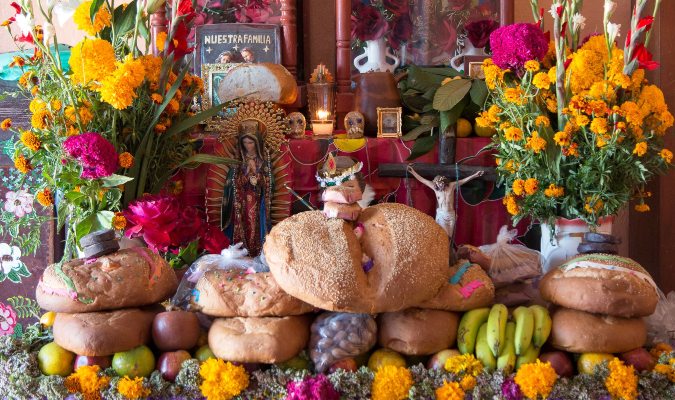
Sugar Skulls
Sugar skulls have become the world-wide symbol for the Day of the Dead and, arguably, an icon of Mexico itself. If you’re celebrating Day of the Dead in Mexico, you’ll see these small skulls made of sugar everywhere during the celebration. They’re typically decorated with colorful patterns of icing and other vibrant motifs, and carry the name of the deceased. Despite being edible, they usually aren’t eaten – think of your teeth! – but instead used as a decoration.
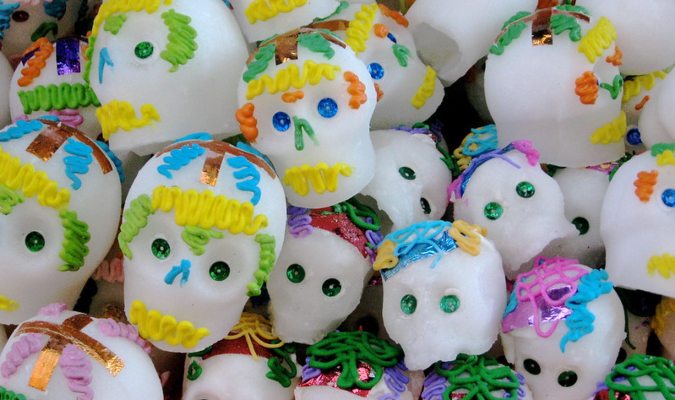
Credit: Katie Bordner/Flickr
Catrinas
Along with sugar skulls, catrinas are Dia de Muertos’ most iconic symbol. Also known as Mexico’s Grand Dame of Death, the image has become a central representation of the whole Day of the Dead festival. The modern version of La Catrina, an upper-class female skeleton, was popularized by artist Jose Guadalupe Posada in his etching La Calavera Catrina. Throughout the Dia de Muertos celebrations you will see catrinas (or catrins if they’re male) everywhere.
Calacas/Calaveras
Calacas are skeleton statues dressed in human clothing while calaveras are their skull equivalent. Throughout Dia de Muertos you’ll see displays of La Catrina calacas, but also other skeletal characters as well. The figures are often brightly painted, happy, and could be dancing or playing an instrument. Their joy indicates that life after death is a happy one.

Pan de Muerto and other food
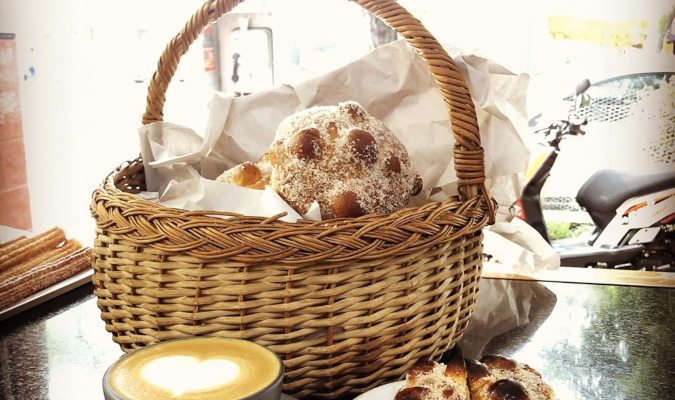
Credit: Cafe Sketck/Facebook
Marigolds/Cempasúchiles
Marigolds (also known as flor de muerto or cempasúchiles) are everywhere during the festivities, but most commonly found as part of the ofrendas. It’s thought that these beautifully orange flowers will help bring the souls of deceased loved ones back to the land of the living.

Papel Picado
Papel picado is the thin, papery flags you’ll see strung across streets and in homes. It has become the traditional flag of the Day of the Dead celebrations and will often have related imagery cut into the pieces.
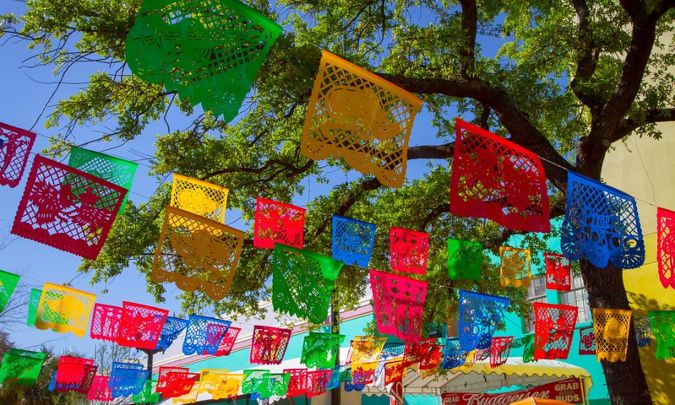
Credit: Stuart Seegar/Flickr
Did You Know? Mexico City Day of the Dead Parade
Whether you see it as an inevitable commercialization of the celebration or a glorious way to celebrate Day of the Dead in style, there’s no doubting that it’s a truly magnificent sight. If you’d like a smaller version of the Mexico City parade, plenty of towns and cities will throw their own version.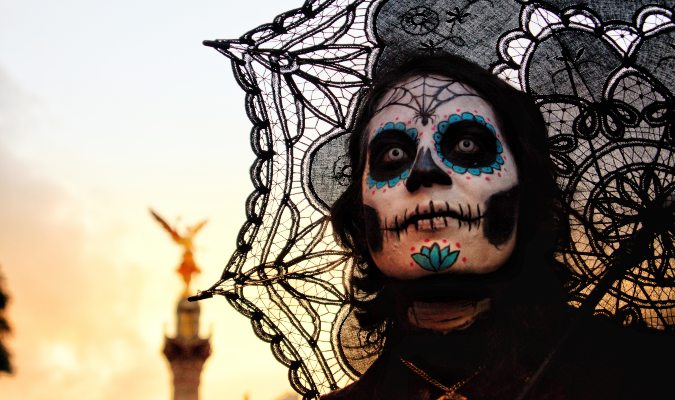
What is Dia de los Angelitos?
November 1 is traditionally referred to as Dia de los Angelitos (Day of the Little Angels) in Mexico and is the day to honor infants and children who have died. November 2 is the actual Dia de los Muertos when families honor adults whom they have lost. It is believed that on these days, the souls of the deceased return to earth to be with their families and loved ones.
Where to Celebrate Day of the Dead
Day of the Dead in San Miguel de Allende
As November approaches, families stream in and out of local cemeteries to scrub tombstones, clear weeds, and lay out flowers and candles. In the weeks before the celebration, a special market is set up near the Plaza Civica where everyone shops for decorations among stalls of sugar skulls, miniature coffins, skeleton puppets and the familiar skeleton masks and figures, known as calacas. The city annually celebrates The Calaca Festival hosting various artistic and cultural events for children and adults.
Read more on our blog: Day of the Dead in San Miguel Allende
Day of the Dead in Michoacán
In the Magic Town of Patzcuaro, Michoacan, there is a small island called Janitzio that many Purepecha indigenous people call home. This indigenous group, also known as Tarascans, have elaborate Dia de Muertos rituals that include processions to the cemetery where they stay from the night until dawn singing and praying. It is traditional for the women and children to create ofrendas (offerings) above their loved one’s tomb while the men gather together to drink and admire from afar. When dark falls, candles illuminate the way to the cemetery, a ritual considered scared by the community.
Day of the Dead in Oaxaca
Oaxaca transforms during Dia de los Muertos as the city prepares to welcome their loved ones’ spirits back to earth. The week starts with Plaza de los Muertos, in which the marketplaces begin to sell everything related to Dia de los Muertos traditions: pan de muerto, calaveras, papel picado, cempasuchils, incense, and so forth. With this, families can buy what they need to create their colorful and vibrant altars in their homes. Arches of bright cempasuchils provide a welcome to spirits who are crossing over. For visitors, Oaxaca has elaborate Day of the Dead altars set up throughout the town and sand tapestry competitions.
Important: Day of the Dead Oaxaca trips need to be booked minimum 8-10 months in advance.
Day of the Dead in Mexico City
While Mexico City holds several events to commemorate the traditions and icons of Dia de Muertos, the most traditional can be found in Mixquic. In the center of this neighborhood is one of Mexico City’s oldest cathedrals and its surrounding cemetery. An incredible altar and intricate carpets sit at the end of the church adorned with gold. Candlelight processions and mourning families join in the graveyard at their loved one’s tombstone throughout the night. Outside, the gate is a complete change of scenery; the neighborhood is a full fair with rides, carnival games, face painting, and entertainment including artistic performances and interpretations of the holiday.
As mentioned previously, Mexico City now throws a vast Dia de Muertos parade. Launched in 2016, this grand, colorful, and noisy parade is a must for anyone in the capital at this time. Expect to see giant skeleton figures, fabulous floats, and face-painted participants wind their way through the heart of the city through Reforma Avenue past the Angel of Independence and finishing at the Zócalo. Want to live this experience for yourself?
Day of the Dead in Aguascalientes
Aguascalientes is the birthplace of Jose Guadalupe Posada, the artist who created the La Catrina symbol that is now very representative of Dia de los Muertos. The city celebrates with a 10-day festival called Festival de las Calaveras. The festival is intended to rescue and preserve the traditions of Dia de los Muertos and pay tribute to Posada. Artists fill the festival recreating some of Posada’s images and actors participate in thematic tours. Cinematic performances, music shows, a Skulls’ Parade, altar building contest, and pan de muerto contest are also essential parts to the festival’s celebration.
Day of the Dead in Riviera Maya/Cancun
Riviera Maya hosts an annual Festival de la Vida y la Muerte (Festival of Life and Death) at Xcaret park in honor of the Dia de los Muertos. At this festival, visitors are encouraged to participate in music and dancing, shop for Day of the Dead trinkets, and try typical Yucatecan fares. Guests can watch parade performances and tour the cemetery to learn about the Mayan burial rituals.
Day of the Dead in Puerto Vallarta
Puerto Vallarta puts on a raft of Dia de Muertos activities, usually starting around a week before the day itself. These include alters in the Plaza de Armas and dance performances at Parque Hidalgo. On Dia de Muertos, the city also holds a catrina parade in which local schools, businesses, and organizations dress up and put on floats.
Day of the Dead in Chiapas
Chiapas is a very special and unique place to experience Day of the Dead as the traditions and customs of the indigenous Tzotzil Maya group remain present to this day. From the fiesta-filled celebration at the sacred burial hill of El Romerillo, to the more solmen grievances of the Amatenango del Valle Cemetery, taking part in these regional traditions is an intimate cultural encounter that is sure to impact any traveler.
Read more on our blog: Day of the Dead in Chiapas
Book a Day of the Dead tour in Mexico
The Day of the Dead celebration is one of the most colorful, moving, and authentic cultural experiences one can have in Mexico. While the festivities differ throughout Mexico, the requirement of planning does not (we recommend at least one year in advance). If you’re interested in traveling to Mexico for Day of the Dead, browse our customizable sample itineraries below or contact Journey Mexico today.
Day of the Dead Trip in Mexico City (Private Tour)
Day of the Dead Trip in Chiapas (Private Tour)
Day of the Dead Trip in Mexico City, San Miguel Allende & Michoacan
Day of the Dead Trip in Oaxaca (Private Tour)

